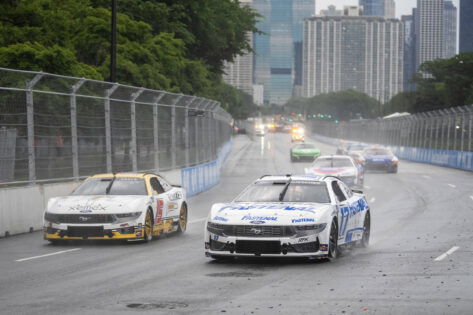Oval, superspeedway, short track, and… now, street circuits? NASCAR’s identity is evolving fast. Once dominated by left turns and high-speed banked ovals, the Cup Series now features a growing diet of road courses and street races. Six in total this year! From Sonoma to Chicago, these technical layouts have flipped the script on what it means to be elite in stock car racing. And not everyone’s keeping up.
Veterans who cut their teeth on ovals are finding themselves outpaced, while a new generation, from Shane van Gisbergen to Tyler Reddick, is thriving in this twist-and-turn era. The very definition of greatness in NASCAR is shifting. And if you’re not adapting, you’re falling behind. So the real question is: In this road-course renaissance, what really makes a great stock car driver today?
A stark contrast in NASCAR drivers
When Shane van Gisbergen swept both the NASCAR Xfinity and Cup Series races on the streets of Chicago, it felt like more than just a win. It was a bold statement! The New Zealander isn’t just fast. He’s redefining what it means to be elite in this era of NASCAR. Street circuits and road courses are no longer just novelty stops on the schedule. They’re now proving grounds for the next wave of superstars.
And it’s not just Shane van Gisbergen making waves. A glance at the 2025 Cup Series road course stats shows a changing of the guard. SVG leads the field with a staggering 3.34 average running position on road courses, well clear of the rest. He’s followed by Christopher Bell (10.09), AJ Allmendinger (10.59), Ty Gibbs (10.92), and Tyler Reddick (11.36). These are all drivers who are known more for precision than pedigree. Their numbers prove the new generation is not just surviving on road courses; they’re thriving, as two of the four drivers here (Bell and Reddick) have made Championship four appearances in the Next-Gen era.
Looking at the broader Next-Gen era in terms of average finish, the trend holds. Chris Buescher boasts an 8.82 average finish on road courses, ahead of Chase Elliott (10.63), Reddick again (11.18), Bell (12.82), and Austin Cindric (12.82). Consistency across multiple seasons confirms this isn’t a fluke. Now, that’s a full-blown shift. Meanwhile, some veterans haven’t exactly embraced the change. And they have been vocal about it without any apologies.
Best average running position on road courses in 2025 pic.twitter.com/a83Cbxwpnj
— NASCAR Insights (@NASCARInsights) July 9, 2025
Brad Keselowski bluntly said, “NASCAR was successfully built as a primarily oval racing series. IMSA was built as the primary road course series in North America. IMSA will always do road racing better than NASCAR, and that’s ok … Yes, TOO many road courses in NASCAR.” Denny Hamlin echoed the sentiment. “Six is a lot, considering that we are NASCAR. We’re short track racing, oval racing, full contact type racing.”
Their on-track numbers reflect that discomfort. Ross Chastain is the only veteran just outside the top 5 (6th place) on road courses this season (12.30 average running position), with Bowman in eighth at 13.77 and Blaney in tenth at 14.20. But what’s more shocking is that the other big veteran names like Kyle Busch, Brad Keselowski, and Denny Hamlin don’t even crack the top 10 of average running position or average finish. That’s 3 championships and 156 Cup Series wins worth of talent struggling to turn right.
The truth? NASCAR’s not just about turning left anymore. As the sport evolves, road course skills are becoming essential. The drivers adapting quickest are climbing fastest, and the old-school resistance is starting to show. With another new road course set to join the 2026 schedule, that shift is only accelerating.
NASCAR eyes San Diego Street Race for 2026
NASCAR is on the verge of making a bold move to the West Coast, with talks intensifying around a potential Cup Series street race in San Diego for 2026. Multiple industry sources report that negotiations between NASCAR and the City of San Diego are progressing, and an official announcement could come as soon as next month. This event would mark NASCAR’s first points-paying race in Southern California since the closure of the Auto Club Speedway in Fontana in 2023.
San Diego’s scenic downtown and proximity to the Pacific Ocean make it an attractive location for a marquee street race. The city’s vibrant tourism industry and iconic waterfront offer a dramatic backdrop, echoing the urban spectacle NASCAR created with its Chicago street race debut in 2023. The move aligns with NASCAR’s strategy to bring stock car racing to major urban centers, aiming to attract new fans and generate local economic impact.
The current Cup Series calendar is maxed out at 38 events. So, adding San Diego would require dropping or relocating an existing race. The Chicago street race’s three-year contract ends in 2025, making it a likely candidate for replacement. However, NASCAR could also shift dates from tracks with two events, as seen with the addition of Mexico City in 2025. While the exact route is still under wraps, insiders expect a downtown layout showcasing San Diego’s skyline and waterfront, similar to the Chicago model.
A San Diego street race wouldn’t just expand NASCAR’s reach. Rather, it would reinforce the message that adaptability is now essential. As younger drivers thrive on mixed terrains, the schedule itself is starting to reflect that shift. San Diego wouldn’t just be a new city on the map. But, it’d be another test of who’s truly built for modern NASCAR. What do you think of NASCAR’s road course shift? Let us know in the comments!
The post How NASCAR’s Shift to Road Courses Is Rewriting What It Means to Be a Great Stock Car Driver appeared first on EssentiallySports.



